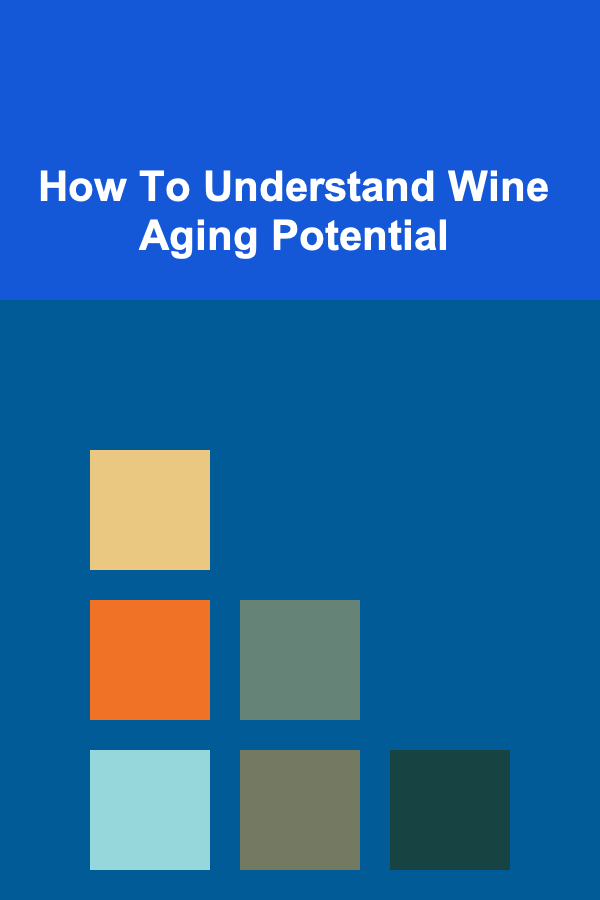
How To Understand Wine Aging Potential
ebook include PDF & Audio bundle (Micro Guide)
$12.99$9.99
Limited Time Offer! Order within the next:

Wine is one of the most celebrated beverages in human history, with its rich cultural heritage, wide variety of types, and deep complexity. Among wine enthusiasts, there exists a distinct appreciation for the potential of wine to improve over time. This process of maturation is often referred to as "aging," and it plays a significant role in determining the quality and value of a bottle of wine. Understanding how to assess and evaluate a wine's aging potential is essential for both collectors and casual drinkers who wish to savor wine at its best.
In this article, we will delve into the concept of wine aging potential, the factors that influence how wine evolves with age, and how to recognize a wine's ability to improve over time. By the end of this discussion, you will have a comprehensive understanding of wine aging and how to make informed decisions about cellaring wine.
What Is Wine Aging?
Aging is the process by which wine undergoes chemical and physical transformations as it interacts with air, temperature, and light over time. These changes can affect a wine's color, aroma, flavor profile, and texture. Aging occurs in two primary phases: maturation in the bottle and maturation in the barrel. While some wines are meant to be consumed young, others require time to reach their peak.
The key idea behind aging wine is that, over time, certain elements in the wine---such as tannins, acids, sugars, and phenolic compounds---soften and become more integrated, leading to a smoother, more harmonious wine. Additionally, the oxidative process that occurs during aging can unlock complex aromas and flavors that may not be immediately apparent in a young wine.
However, not all wines are made with the intention of aging. Most wines are produced to be consumed within a few years of release, and their flavors may not improve significantly with time. On the other hand, wines that are designed for aging, often called "age-worthy wines," will benefit from extended cellaring.
Why Do Some Wines Age Better Than Others?
Not all wines are capable of aging for extended periods, and the ability of a wine to age is influenced by a combination of factors, ranging from grape variety and winemaking techniques to environmental conditions. To understand how aging works, we must first look at the elements that contribute to a wine's aging potential.
1. Grape Variety
The grape variety used in wine production plays a crucial role in determining whether a wine has aging potential. Some grape varieties are naturally more suited to aging due to their higher levels of acidity, tannins, and phenolic compounds. For example:
- Cabernet Sauvignon: This variety is known for its high tannin content and acidity, making it a prime candidate for aging. As the wine matures, the tannins soften, and the wine develops complex flavors.
- Pinot Noir: Pinot Noir tends to have lower tannin levels, but its high acidity and delicate structure allow it to age gracefully, developing earthy, floral, and fruity notes over time.
- Nebbiolo: Known for its tannic structure and high acidity, Nebbiolo wines, such as Barolo and Barbaresco, are celebrated for their aging potential, often requiring years or even decades to reach their full complexity.
- Sangiovese: The primary grape of Chianti and Brunello di Montalcino, Sangiovese's balance of acidity and tannin allows it to age well, developing aromas of dried fruit, leather, and spices.
2. Tannins
Tannins are phenolic compounds found in grape skins, seeds, and stems. They are responsible for the astringency and mouth-drying sensation in wine. Tannins also act as natural preservatives, protecting the wine from spoilage and allowing it to age. Wines with higher tannin content, such as red wines made from Cabernet Sauvignon, Syrah, and Nebbiolo, have a greater capacity for aging.
As a wine ages, its tannins soften and become more integrated with the other components, leading to a smoother texture and more balanced flavor profile. However, wines with low tannin content may not age as well, as they lack this protective structure.
3. Acidity
Acidity is another crucial factor in determining a wine's aging potential. Wines with higher acidity, such as those made from Sauvignon Blanc, Riesling, or Chardonnay, tend to age better because acidity helps preserve the wine and prevents it from becoming flat or oxidized over time. High-acid wines maintain their freshness and brightness even as other elements evolve.
In contrast, wines with low acidity may lose their vibrancy more quickly as they age, resulting in a duller, less interesting wine.
4. Sugar Content
Sweet wines, such as Sauternes, Tokaji, or Icewine, tend to have excellent aging potential due to their high sugar content. The sugar acts as a preservative, preventing oxidation and allowing the wine to develop rich, complex flavors over time. These wines may evolve in fascinating ways, developing honeyed, nutty, and dried fruit notes as they mature.
Dry wines with lower sugar content do not have the same level of protection, making them more susceptible to deterioration over time.
5. Alcohol Content
Wine's alcohol content also influences its aging potential. Higher alcohol levels can help preserve a wine, as alcohol acts as a natural preservative. Wines with alcohol content between 12.5% and 14.5% tend to age well, as the alcohol helps to stabilize the wine without overwhelming the flavors. However, wines with excessively high alcohol content (above 15%) may suffer from an imbalance, where the alcohol dominates the flavor and interferes with the aging process.
6. Winemaking Techniques
The techniques employed during winemaking can also affect a wine's aging potential. The use of oak barrels, for instance, can impart tannins and flavor compounds that help preserve the wine and improve its structure over time. Similarly, extended maceration (where the grape skins are in contact with the juice for an extended period) can increase the tannin levels and enhance the wine's aging potential.
Modern techniques such as micro-oxygenation, which involves introducing small amounts of oxygen into the wine during fermentation, can also improve the wine's texture and aging potential.
7. Storage Conditions
Proper storage conditions are essential for ensuring that a wine ages gracefully. Wine should be stored in a cool, dark place with a consistent temperature, ideally between 50°F and 60°F (10°C to 15°C). Exposure to light, heat, and temperature fluctuations can accelerate the aging process and cause the wine to deteriorate prematurely.
Wine should also be stored on its side to keep the cork moist, which helps prevent air from entering the bottle and spoiling the wine. Humidity levels should be maintained around 70% to prevent the cork from drying out.
How to Assess a Wine's Aging Potential
While the factors mentioned above can provide a good indication of whether a wine is likely to age well, there is no surefire way to predict exactly how a wine will evolve over time. However, there are some key characteristics that wine enthusiasts can look for when assessing a wine's aging potential.
1. Structure
A well-structured wine, with balanced acidity, tannins, and alcohol, is more likely to age well. Wines with high tannin content and acidity are generally better suited for aging, as these elements help preserve the wine and allow it to evolve gracefully. A wine with good structure will also have the ability to withstand oxidation and develop more complex flavors over time.
2. Balance
Balance is an important consideration when assessing a wine's aging potential. A wine that is overly acidic, tannic, or alcoholic may not age well, as these characteristics can become more pronounced as the wine matures. On the other hand, a wine that is too soft or lacks structure may not have the necessary components to improve with age. Wines with a harmonious balance of fruit, acidity, tannins, and alcohol tend to age better and evolve in interesting ways.
3. Complexity
Complexity is a hallmark of age-worthy wines. Wines with a wide range of aromas and flavors, such as fruity, floral, earthy, and spicy notes, are often more capable of developing further complexity as they age. Wines that are overly simple or one-dimensional may not have the depth required to improve over time.
4. Fruitiness
While most wines lose some of their fresh fruitiness as they age, wines with a strong fruit character tend to age more gracefully. The fruit flavors may evolve into dried fruit, jam, or candied notes, but they should still remain recognizable. Wines that are overly acidic or tannic may lose their fruit character more quickly, leaving them unbalanced and less enjoyable.
How Long Can a Wine Age?
The aging potential of wine varies depending on the factors mentioned above, as well as the type of wine in question. Some wines are designed to be consumed young, while others benefit from extended aging. Here are some general guidelines for how long different types of wine can be aged:
- Red Wines: Many red wines, especially those made from tannic varieties like Cabernet Sauvignon, Syrah, and Nebbiolo, can be aged for several years to decades. However, lighter reds like Pinot Noir may be best consumed within a few years of release.
- White Wines: White wines tend to have a shorter aging potential than reds, but some varieties, such as Chardonnay, Riesling, and Chenin Blanc, can age for several years and even decades.
- Sweet Wines: Sweet wines, like Sauternes and Tokaji, have excellent aging potential and can often improve for decades, developing complex honeyed, nutty, and dried fruit notes.
- Sparkling Wines: Most sparkling wines, such as Champagne, are best consumed within a few years of release. However, vintage Champagnes and other high-quality sparkling wines can age well for 10 to 20 years or more.
Conclusion
Understanding wine aging potential is essential for appreciating the true beauty and complexity that wine can offer. While factors such as grape variety, tannin content, acidity, and winemaking techniques all contribute to a wine's ability to age, it is also important to remember that aging is a dynamic process that varies from bottle to bottle. By understanding the factors that influence aging and how to assess a wine's potential, you can make more informed decisions about when to drink or cellar your wine, allowing you to enjoy it at its peak.

Becoming a Healthcare Consultant: Key Skills for Delivering Impactful Solutions
Read More
How to Create a Holiday Photo Wall to Capture Memories
Read More
How to Make Money Online as an Illustrator: 10 Actionable Ideas
Read More
Making Money with AI: How Deep Learning Can Generate Passive Income
Read More
How to Understand the Genetics of Complex Traits
Read More
How to Get Enough Protein for Weight Loss: A Comprehensive Guide
Read MoreOther Products

Becoming a Healthcare Consultant: Key Skills for Delivering Impactful Solutions
Read More
How to Create a Holiday Photo Wall to Capture Memories
Read More
How to Make Money Online as an Illustrator: 10 Actionable Ideas
Read More
Making Money with AI: How Deep Learning Can Generate Passive Income
Read More
How to Understand the Genetics of Complex Traits
Read More